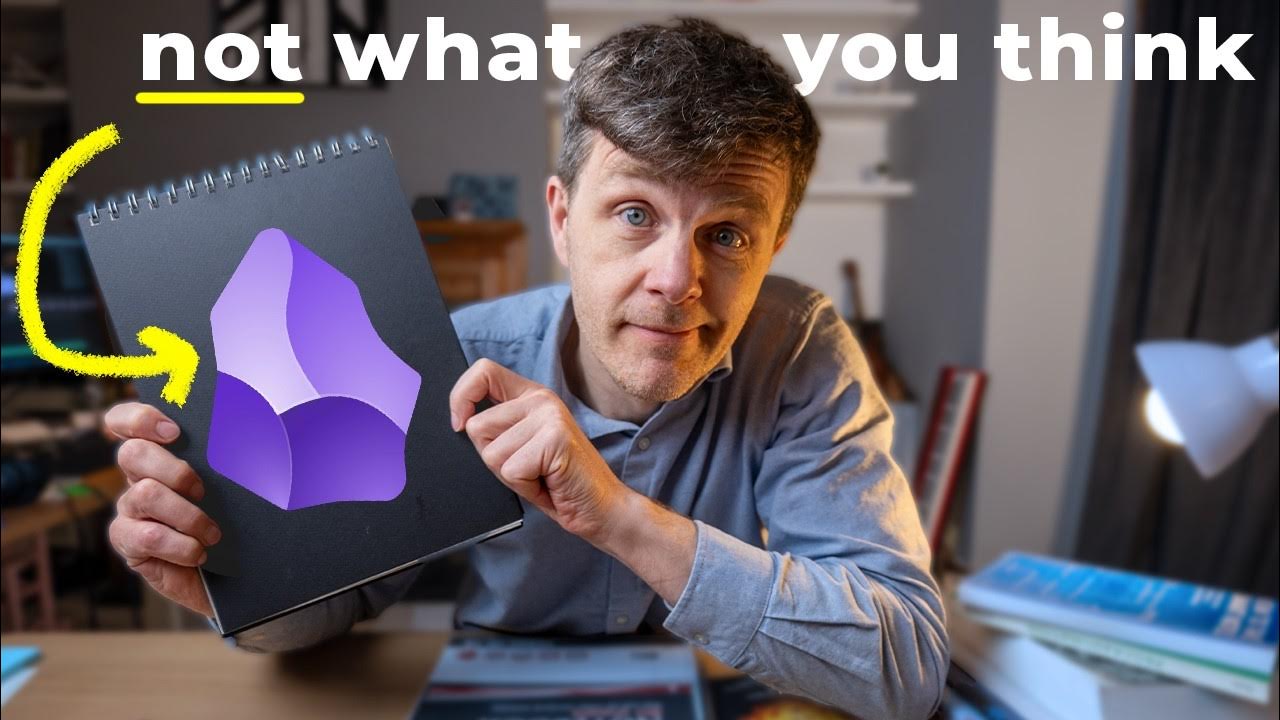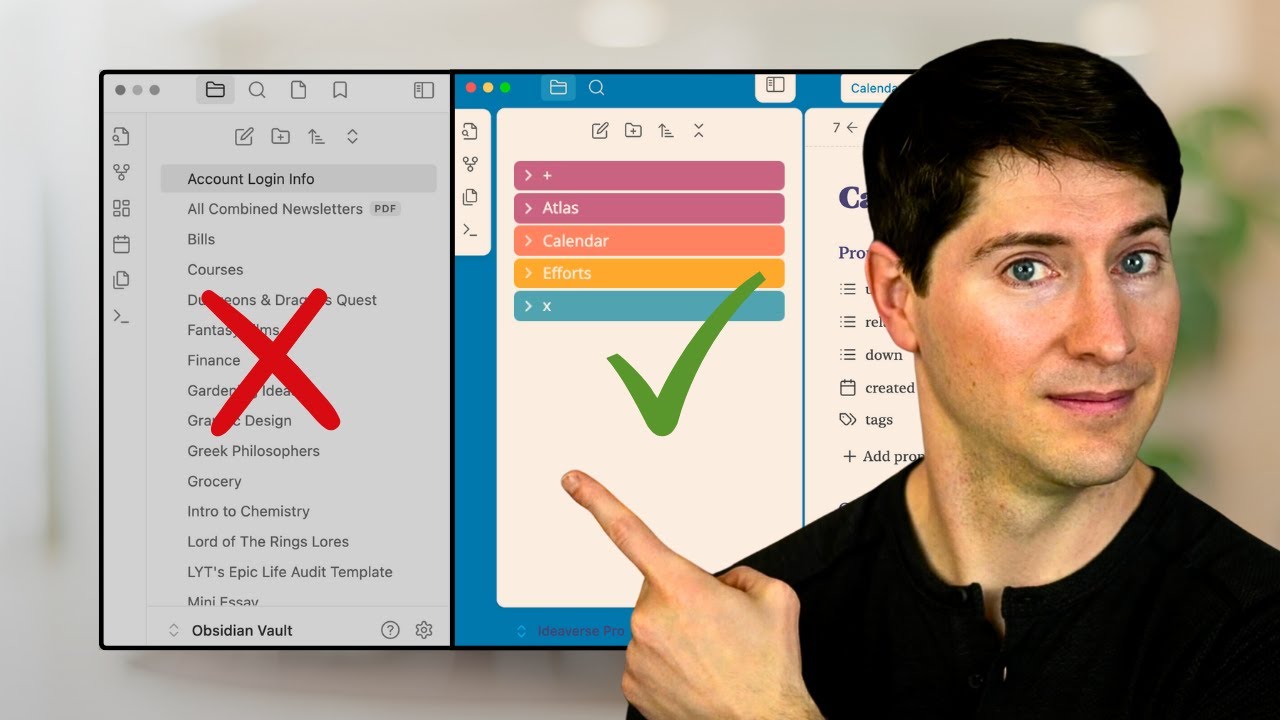Solving The Folder, Tags, Links Debate With MOCs (Maps of Content)
Summary
TLDRThis video explores the concept of Maps of Content (MOCs) in Obsidian as a powerful method to organize your notes. MOCs link related notes together, reducing the need for traditional folders and tags while providing a clear, intuitive way to visualize connections between ideas. The video covers the five levels of MOC emergence, from a collection of isolated notes to a fully connected system, culminating in a central 'Home Note' that ties everything together. The presenter shares their personal experience and encourages viewers to try this approach for better organization and deeper learning.
Takeaways
- 😀 MOCs (Maps of Content) are an effective way to organize and link notes in Obsidian, offering an alternative to traditional folders and tags.
- 😀 A map of content is essentially a note that links to other related notes, serving as a dashboard or overview for a specific topic.
- 😀 MOCs help reduce the need for complex folder structures and allow for more intuitive, organic organization of ideas.
- 😀 The five levels of MOC emergence (from initial note creation to linking with other MOCs) help build complex, interconnected systems of knowledge.
- 😀 Level 1: The emergence of a MOC starts with a single note that serves as a collection of related ideas or information.
- 😀 Level 2: Notes begin linking to each other, forming relationships and connections between previously isolated ideas.
- 😀 Level 3: The MOC evolves into a more structured format, such as a bullet list or paragraphs, for better navigation and overview.
- 😀 Level 4: MOCs start to link to other MOCs, creating a network of interrelated topics that allows for more expansive thinking.
- 😀 Level 5: The highest level of emergence involves creating a 'home note,' which serves as a central hub for all major MOCs in the system.
- 😀 The power of MOCs grows over time as you continue to build links between notes, MOCs, and home notes, turning your vault into an interconnected body of knowledge.
- 😀 Using MOCs can increase curiosity and motivation by offering a more dynamic and organic approach to knowledge building, making learning more engaging.
Q & A
What is a Map of Content (MOC) in Obsidian?
-A Map of Content (MOC) is a note in Obsidian that links to other related notes. It serves as a dashboard, an overview, or a hub for a specific topic, helping you organize your notes by connecting them through links.
How do MOCs help with organizing a large number of notes in Obsidian?
-MOCs reduce the need for folders and tags by using links as the primary organization tool. They allow you to connect related notes and build an interconnected web of knowledge, making it easier to navigate and see relationships between ideas.
Can MOCs be used in any way to visualize the relationships between notes?
-Yes, MOCs help visualize relationships by linking related notes together. You can also use Obsidian’s graph view to see how these links evolve over time, providing a visual representation of your interconnected knowledge system.
What are the five levels of MOC emergence?
-The five levels of MOC emergence are: 1) The seed (a single note or idea), 2) Initial connections (linking related notes), 3) Building a map (assembling notes into a list or structure), 4) Cross-linking MOCs (linking different MOCs together), and 5) The home note (a high-level MOC linking to other major MOCs).
What is the benefit of creating a home note in Obsidian?
-The home note serves as a central hub for your vault. It links to your highest-level MOCs and helps you view your entire knowledge system from both top-down and bottom-up perspectives. It makes navigating your vault easy and serves as a launchpad for further exploration.
How does the process of building MOCs change if you already have existing notes in Obsidian?
-If you already have existing notes, you start by linking them together, gradually building a structure that forms your MOC. This process may be faster as you gather related notes and create connections, but it requires organizing these notes into a coherent framework.
What is meant by 'mental squeeze point' in the MOC creation process?
-A mental squeeze point occurs when you have so many unorganized notes in your vault that you feel the need to start organizing them. It’s the moment when the chaos of unstructured notes prompts you to begin the MOC creation process.
How do MOCs reduce the need for folders and tags?
-MOCs focus on linking related notes instead of using folders or tags. By creating MOCs, you can organize your notes using meaningful connections and relationships rather than arbitrary categories, which reduces the need for complex folder structures or extensive tagging.
Can MOCs evolve over time as new notes are added?
-Yes, MOCs can evolve over time. As you create and add more notes, your MOCs grow, adapt, and expand. This evolution helps to build a richer, more interconnected knowledge system that reflects your ongoing research and learning.
Why should someone consider migrating their notes into Obsidian if they’re using another system?
-Migrating to Obsidian can be beneficial because it provides a more flexible and powerful system for linking notes, creating MOCs, and building an interconnected knowledge base. However, it’s important to evaluate whether migration will truly enhance your workflow before committing to it.
Outlines

This section is available to paid users only. Please upgrade to access this part.
Upgrade NowMindmap

This section is available to paid users only. Please upgrade to access this part.
Upgrade NowKeywords

This section is available to paid users only. Please upgrade to access this part.
Upgrade NowHighlights

This section is available to paid users only. Please upgrade to access this part.
Upgrade NowTranscripts

This section is available to paid users only. Please upgrade to access this part.
Upgrade NowBrowse More Related Video

Maps of Content - Organize and Think with MOCs 💭

Here Is How I Use Tags 🏷️ And Links 🔗️ In Obsidian To Manage My Zettelkasten 📝️

Obsidian: The Most Powerful Learning Technology in History?

My simple note-taking setup | Zettelkasten in Obsidian | Step-by-step guide

ZETTELKASTEN: Como aprender mais rápido usando o Método Zettelkasten

What Nobody Tells You About Organizing Folders in Obsidian
5.0 / 5 (0 votes)